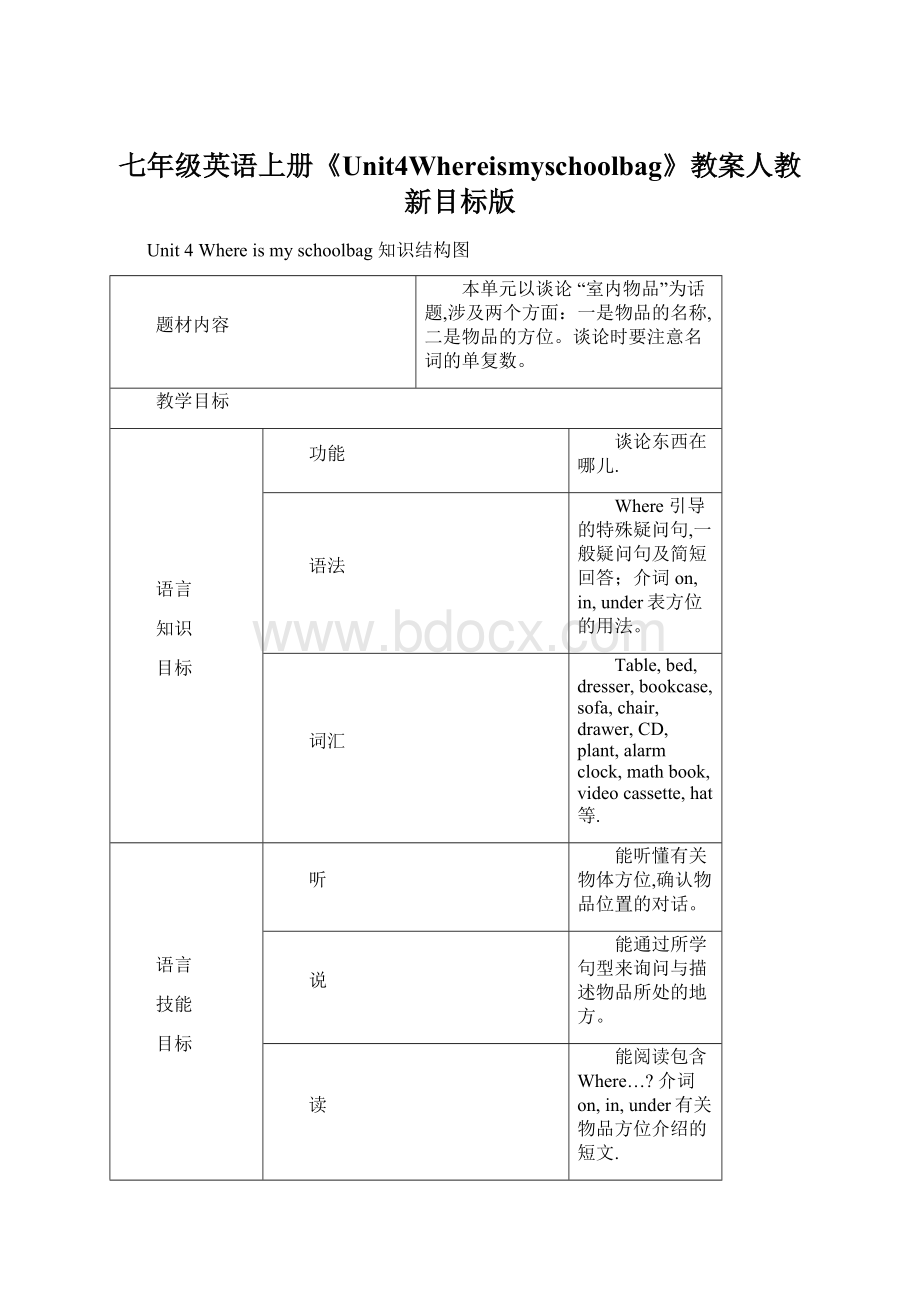七年级英语上册《Unit4Whereismyschoolbag》教案人教新目标版Word文档下载推荐.docx
《七年级英语上册《Unit4Whereismyschoolbag》教案人教新目标版Word文档下载推荐.docx》由会员分享,可在线阅读,更多相关《七年级英语上册《Unit4Whereismyschoolbag》教案人教新目标版Word文档下载推荐.docx(15页珍藏版)》请在冰豆网上搜索。

文化
意识
进一步了解中西方家庭教育的差异。
情感
态度
通过认知物品的位置,引导学生要爱护和管理好自己的东西。
通过设计理想房间,使学生的空间意识得到扩展训练,为自己营造舒适的学习环境.
任务
能运用所学知识介绍自己的房间布置,能请人帮你拿东西。
题目
Where’smybackpack?
知识点解析:
1、名词的单复数形式(不可数名词一般没有复数形式)
﹡名词复数的部分规则:
情况
构成方法
读音
例词
一般情况
加-s
清辅音后读/s/浊辅音和元音后读/z/
Book-bookshat-hatsapple-apples
以O结尾的词
加-s或–es
读/z/
Tomato-tomatoespotato-potatoesphoto-photos
以s,sh,ch,x等结尾的词
加-es
Bus-buseswatch-watches
以ce,se,ze,(d)ge等结尾的词
Price-pricescase-cases
以辅音字母加y结尾的词
变y为i,再加-es
Comedy-comediesparty-parties
注:
1)少数名词的单复数形式是不规则的,如man→menwoman→womenchild→children foot→feet tooth→teethmouse→mice sheep→sheepdeer→deerfish→fish
2)表示民族的名词,有的在词尾加-s,有的单复数形式相同,如:
Chinese,Japanese
3)news是不可数名词。
2、介词解析(on,in,under)
a)in表示“在……中(内)。
在某个空间内部
b)on表示“在……上”,在一个面上,通常指一个人或物体在另一个物体的上面,二者之间有接触。
c)under表示“在……下面”通常指一个人或物体在另一个物体的垂直下方,二者之间往往没有接触。
3、同近义词辨析
a)table与desk:
“table”指供人们吃饭,喝茶,游戏,娱乐用的“餐桌,桌子、”等。
一般都不带抽屉,可以是方的也可以是圆。
“desk”指学生学习时用的“课桌,书桌”。
老师,办公室人员用的“办公桌”等,一般都带有抽屉。
b)onthebed与inbed:
“onthebed”在床上,指某东西在床上。
“inbe
d”卧床,指人因病卧床,或卧床休息。
c)take与bring:
“take”意思为“带走;
拿走”,指从说话人所在的地方带走某人或某物。
“take…to….”意为“把…..带到(给),把…….拿到(给)”。
“bring”意思为“带来,拿来”,指把某人或某物带到说话人所在的地方。
“bring…to….”意为“把…..带来….,把……拿来…..”。
d)hat与cap:
“hat”指“帽子”时,表示有边的帽子,礼帽。
“cap”指“便帽;
军
(瓶帽);
(笔帽)”
4、定冠词the的用法
(1).用来特指某人或某事物。
Eg:
Thebookonthedeskisourteacher’s.
(2).常用在上下文提及的人或事物。
(3).用来指说话人双方都知道的人或事物。
Whereistheteacher?
(4).表示世界上独一无二的事物eg:
hesun太阳themoon月亮theearth地球
(5).用在序数词前eg:
Wehavesomeclassroomsonthethirdfloor.
(6).用在某些专有名词前eg:
theGreatwalltheUSA
(7).用在最高级前eg:
Whichisthebiggestanimalonland?
(8).用在一些习惯用语中eg:
Inthemorning\afternoon\evening
(9).用在乐器前eg:
playthepiano\drums\violin
5、where引导的特殊疑问句。
“where”是特殊疑问词,意为“在哪里,在哪儿”,用来询问地点,位置,处所。
基本句型
为“Where+系动词+限定词|+名词?
”意为“某人或某物在哪儿?
”当某人或某物
是复数是,be动词用are,某人或某物为单数时,be动词用is,where与is常缩写为
Where’s,where与are一般不缩写。
教学活动设计:
测眼力:
限时找出两个房间物品的不同。
提高学生的兴趣及积极性。
记忆新词活动:
将实物图片用滑动法呈现,测学生的瞬间记忆,巩固新词的学习。
小组活动:
2人1组,甲生闭眼,乙生将其文具藏起,甲猜物品位置,直至猜中为止。
两人轮流猜,猜测次数少的获胜。
Unit4Where’smybackpack?
Teachingdesign:
Period1:
SectionA(1a—1c)
Period2:
SectionA2a,2b,2c,3a,3b,3c,4
Period3:
SectionB1a,1b,1c,2a,2b
Period4:
SectionB3a,3b,3c,4,Self-check
PeriodOne
SubTopic
Talkabouttheroom
Functions
Talkaboutwherethethingsare.
Vocabulary:
where,table,bed,dresser,bookcase,sofa,chair,drawer,plant,in,on,under,they,they’re=theyare
Structures
Where’s…?
It’sin/on/under…
Where’re…?
They’rein/on/under…
Tasks
Listing
Makeasurvey
StepIWarmingup
●PlayanEnglishsongbeforeclass.
●Revisesomeschoolthingsbyaskingquestions.
e.g.:
What’sthis?
Isthisa…?
Howdoyouspellit?
etc.
●Learnthenewwordsin,on,under,behind…byhelpingtheteacherfindthelostthings.
e.g.:
T:
Where’smyEnglishbook?
S1:
It’shere./Ithinkit’s…
T:
Oh,it’sonthedesk.
…
Where’remycolorpencils?
S2:
…
Teachthenewword“where”andtheuseof“they”.
●Consolidatetheprepositionsbylookingatthescreenandanswerthequestions:
Where’s…?
Where’re…?
StepIIPresentation
一、Newwordslearning
●Show
thestudentsapictureofaroom,tellthemthisisabedroom,letthestudentslistthethingsinitfirst.Thenshowthemthewholepicture,teachthenewwords,askwherethethingsare,letthestudentsanswer,usingtheprepositions.
●Repeatwithasittingroomandastudy,teachthenewwordsandpracticeinthesameway.
(设计意图:
由于课前引导学生通过自主学习初步接触本课要学的新单词,所以在新单词的教学过程中,一些有能力的学生可以将自己已有的认识水平与实际运用结合起来,使他们能体会到通过自主学习带来成功的满足感。
通过这样的方法呈现新单词,效果远比教师单纯地用图片来传授新单词要大。
)
二、WorkonSectionA1a~2b
1.Finish1a:
Matchthewordswiththethingsinthepicture(1min)
2.Inviteastudenttosaytheanswer,like:
“table”isPictureE.
3.Dothe1b:
Listenandnumberthethingsinthepicturewhenyouhearthem.
StepIII:
Listenandsay
ListenandimitatethedialoguesinSectionA,1b.
StepIVPairwork(Makeadialoguewiththeclassmate)
Lookatthepicturein1aandthenmakeadialogueasfollow:
Where’sthebackpack?
S2:
It’sunderthedesk.
Thanks.S2:
You’rewelcome.
StepV:
Summary:
Amemorytest
Showapictureofaroom,givethestudentsoneminutetolookatit,thenaskthemwhatkindofthingstheysawandwherethethingsare.Haveacompetitionamonggroups.Seewhichgroupcanrememberallthethingsandplaces.
通过这种活动调动学生的视觉、感觉和记忆力来参与语言活动,并且使本课的主要语言知识得到重现,加深印象;
同时,小组之间的竞赛体现了协作和团队精神。
StepVIHomework:
●Copythenewwordsandtrytorememberthem.
●Makeasurvey:
Interviewoneofyourfriendsorteachers.Fillintheform
below.
Name
Things
Places
Ms.Zhang/
LiuHai
sofa
nearthewall
设计意图:
语言知识学习与实际生活相结合,培养使用英语的思维。
板书设计:
Unit4Whereismybackpack?
pen,ruler,----Whereisthebook?
backpack,----It’sonthedesk..
keys,asetofkeys----Wherearethepens?
sofa,dresser,drawer….----Theyareinthedesk.
教学反思:
PeriodTwo
Talkaboutwherethethingsare
Recycledlanguage
Whereis…?
It’son/in/under…
Whereare…?
They’rein/on/under…?
Structure
Isthebook/Arethebooksonthedesk?
Yes
…/No,…
Idon’tknow.
Listing
Comparing
StepIWarmingup
Chatting.Chatwiththestudentsaboutthethingsaroundtheroombyshowingthempictures.Askthestudentstospellthenewwords.
根据学生的年龄特征,他们非常喜欢这种情景猜测活动。
这可以调动他们各方面的情绪来参与语言活动,激活他们已有的知识水平。
StepIIListenandimitate
1.SectionA,2a.Revisewhatthethingsare.Playthetapeforstudentsandletthemnumberthem.
2.SectionA,2b.Playthetapeagain,studentsnumberthethings[1-6]inthepicture.Imitatethedialogues.
StepIIIAguessinggame
Aguessinggame.Showthestudentsapictureofaroomwithafewthingsinit.Havethemguesstheplacesoftheotherthings.
Thereisabookcaseinit.Isthebookcasenearthebed?
Ss:
Yes,itis./No,itisn’t.
(Writethegeneralquestionandtheanswersontheblackboard.)
StepIVPairwork
SectionA,2c.Lookatthepicturein2bagain.Studentsusegeneralquestionstoaskandansweraboutthethingsinit.
StepVGame:
Findthedifference
SectionA,4.StudentAlooksatPicture1(TextbookP21.4),StudentBlooksatPicture2(TextbookP19,1a).Askandanswerinpairsandfillintheform.
SA:
Whereisthebackpack?
Isitunderthetable?
SB:
No,itisn’t.It’sonthetable.
Picture1
Picture2
backpack
underthetable
onthetable
pencilcase
books
keys
dog
Asksomestudentstoreporttheiranswerlikethis:
InPicture1,thepencilcaseis…InPicture2,thepencilcaseis…;
InPicture1,thebooksare…InPicture2,thebooksare…
设置任务,通过对比的方式让学生理解方位介词。
利用表格直观体现出两幅图的不同点, 再将它的不同点复述出来,其目的在于培养学生的语言组织能力。
StepIVPracticethedrill“Whereis/are…?
”
Presentshortdialogues,usingpicturesorobjectstohelp.
Dialogue1:
A:
Where’smybag?
B:
Idon’tknow.Isitonthesofa?
A:
No,itisn’t.
Dialogue2:
A:
Where’remybooks?
B:
Idon’tknow.Aretheyonthebed?
Yes,theyare.
CheckthehomeworkinPeriodOne.Makereportstosharetheinformationtheygotfromthefriendsorteachers,andgivetheirsimplyassessment.
话题由课本知识向实际生活延伸,体现语言的语用原则。
StepIIVSummaryandHomework:
Finish
offtheexercisesintheexercisebook(SectionA)
------Isitunderthechair?
------Yes,itis./No,itisn’t.
-----Aretheyinthedesk?
------Yes,theyare./No,theyaren’t.
教学反思:
PeriodThree
Talkabouttheroom
Alarmclock;
videocassette;
CD;
mathbook;
computergame
It’sin/on/under
They’rein/on/under…
Themathbookisonthedresser.
TheCDsareonthebookcase.
……
Listing&
sharing
AsksometoactoutthedialoguesinSectionA,2a&
2b.
StepIIPresentation
1、Newwordslearning
Showt
hestudentsapictureofaroom.Letthestudentssaylikethis:
Thealarmclockisonthetable.
Thebooksareonthechair.
Letsomestudentslistsomenewwords.Practicereadingthem.
2、Teachershowstwopicturestothestudentsandasksthestudenttofindouttheirdifferences,thenfillintheblank.
TheCD
Theclock
Thehat
Thealarmclock
Themathbook
Thetapes
3、Supposethestudentstouseasentencetodescribethedifferencesintwopictures
Eg:
In